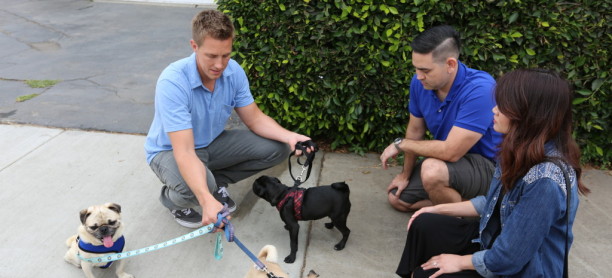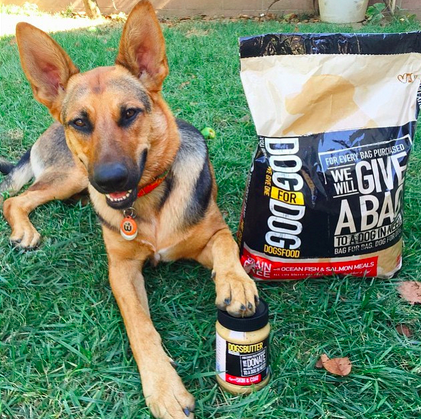Introducing a New Rescue Dog to Your Pack
Maybe you strolled by them at your local shelter, saw a shared photo on Facebook or heard about a dog in need from a friend or coworker. Whatever the steps that got you there, if you’re bringing home a new furry friend to live with your pack, you’ll want to be prepared for how you introduce them to your home and their new doggie siblings. Deep breaths, you can do this! We’ve broken down the basic steps you’ll want to take when you’ve rescued a new pup.
Before you bring them home: First of all, congrats! You’ve saved a life and taken the first step into expanding your loving home. While there will be missteps and lessons to be learned along the way, what’s happening here is exciting and awesome all-around. Be real with yourself about the work and patience that will go into making everyone in the family happy and comfortable and try not to make yourself too crazy about impending obstacles. With perseverance and a good attitude, the transition for all involved can be relatively painless. Also recognize that like anything else in life, every dog is different and every family goes at a different pace. Whether it’s smooth sailing from hour one or a rocky start, you can smooth the edges and make this thing fly!
First things first, make sure you have the supplies needed for your new pup. Leash, collar, food bowls, bed and any other essentials they’ll need to feel comfortable in your new home. Once you’re all set, you’ll want to get to introducing them to the rest of your troop. Whether you decide to do this before adopting (shelters and rescues will generally encourage you to do so and give you the time and space for that) or after, arrange to have a friend who knows your current dogs well to help you out. You’ll want to meet on neutral territory, so not inside your home or on a walk in a place you already often take your current pups. Meet the new addition and your friend at a neutral place and go on a long walk. Dogs can bond more easily in neutral territory that neither of them “owns” and walking together is a great way to have them get to know each other while exercising and not feeling the need to protect anything.
To begin the walk, take the lead of your existing pack and have your friend or family member follow behind you with the new dog. Both you and your friend should keep the leashes loose, staying in command but not pulling or choking either pup, even if they’re excited. After a bit, you can hang back and allow the dogs to meet. As you continue to walk, keep them seperated a bit with the humans in the middle. If all seems well, you’re ready to go home! When you arrive at the house, let your older pack go in first and then follow with the new member. At home, try to give equal attention and affection to both your older and new dogs. Just like humans, dogs can get jealous of the new guy, and dog parents can also misstep by showing more fondness for their older dogs whom they know better. Treating them all equally will teach them to have a fair hierarchy amongst themselves. It’s totally normal that one dog – no matter which one – will display more dominance over another, whether it’s right away or later on. There’s nothing to fear here, as animals will make their natural place in the pack just as humans do at work or at home. They’re choosing their comfortable place and in most cases, their place within the family unit. Don’t assume that if the new guy becomes a bit of a “follower,” that he or she is less happy. It’s kind of funny to think about, but it’s true! Some dogs prefer to be submissive while others will always be more dominant.
When you first arrive at home: Make sure to pick up any toys off of the floor. Even if your current dogs play well together, it will take a bit of time to ensure safe playing amongst them and your new guy or gal. You’ll want to introduce this slowly. Put the new dogs bed near your other dogs beds, and their crate (if you’re using one) with theirs as well. Maybe one of your older dogs will take over the newer bed and the new one will take an older bed – these kinds of things shouldn’t matter much, as long as you don’t see your pack becoming territorial or not allowing the new addition to lay down. It may be tempting to separate them at first, but this can set a weird hierarchy that confuses your older dog(s). Adding them in as part of the pack reminds your older dogs that the new one is a part of the team. What you should keep separate, at least slightly at first, is feeding time. Be sure to be present for this and keep the new dog and bowl at least on the other side of you, especially if your current pack has had any previous issues with feeding time. Pick up empty bowls as soon as they are finished, as even an empty bowl can incite a fight. And be sure to have enough water bowls available that everyone can have their own after coming in from a walk or finishing playing. Maybe they’ll be able to share eventually, but for now they have their own bowl to retreat to.
What the first 48 hours should look like: Use positive reinforcement to let everyone know that they’re doing a good a job. Be sure to supervise all interaction yourself, from feeding time to play time to down time. Have a friend or family member help you out with initial walks that first week, and keep a watchful eye on feeding time and playtime. Pay attention for any negative behavior. While it’s normal for older dogs to “correct” (growl lowly) new additions (especially puppies), this is normal and not to be worried about unless it escalates or happens too often. Watch your dog’s behavior – are they bowing and wagging their tails, eager to play? Or are they staring at the new addition, with a wide gait? Body language can tell you a lot about how your dogs are feeling. Try to acclimate your new addition to the routine you and your pack have had. Morning and evening walks, feeding time – your older dogs will show them the ropes and they will quickly adjust knowing when the good stuff is about to go down.
For now, treats are likely okay but chews and toys should be played with separately. This only needs to last for the first couple of weeks, but allows the pack to get comfortable and know that while everyone is still going to get to munch on their favorite stuff, that also includes the new guy. If and when you have to leave the house, it’s safest to separate the new addition. Even if it seems like everything is totally fine, it’s good to do this for the first week or so to prevent the new one from getting ganged up on without the human pack leader around. Be sure to sincerely praise your pups when they play well with each other, reward them and spend equal time individually with each. If one dog is younger, they might need more stimulation or playtime than the other(s) can keep up with. It’s best to keep every dog at the level of exercise and stimulation that they need. It’s also good if they can all spend time with other dogs outside of the home as well, whether it’s at daycare or the dog park.
Once everyone is getting settled in: Yay, you made it! See, it wasn’t that bad. While adjustment will likely take longer than the first two days, you should already be seeing a level of comfortability with your new addition. Be sure to take photos of your new guy or girl with your older crew and send them along to the rescue or foster group who got you to them. They’ll be so happy to see the dog that they nurtured comfy and relaxed in their new home. Keep up what you’re doing and be sure to continue your routine and research into keeping the kumbaya in your current situation. As time goes on, you’ll see your pets bond in new and beautiful ways! Seeing issues creep up? Be sure to contact a trainer ASAP. It’s important to nip problems in the bud immediately, as they only escalate and can do so quickly. If you jump right on bad behavior, you can often turn it around before it turns into a full blown issue.
Have you recently added a new addition to your home? In the comments below, tell us your tips for adding another rescue to the mix, and any valuable lessons you’ve learned along the way.


 Five Reasons Why Donating Dog Food to a Shelter Makes a Difference
Five Reasons Why Donating Dog Food to a Shelter Makes a Difference Five Reasons Why Donating Dog Food to a Shelter Makes a Difference
Five Reasons Why Donating Dog Food to a Shelter Makes a Difference Adopting 101: Size, Breed, and Energy Levels
Adopting 101: Size, Breed, and Energy Levels 6 Tips for Adopting the Right Match
6 Tips for Adopting the Right Match Save Our Shelter with Cathy Bissell
Save Our Shelter with Cathy Bissell




